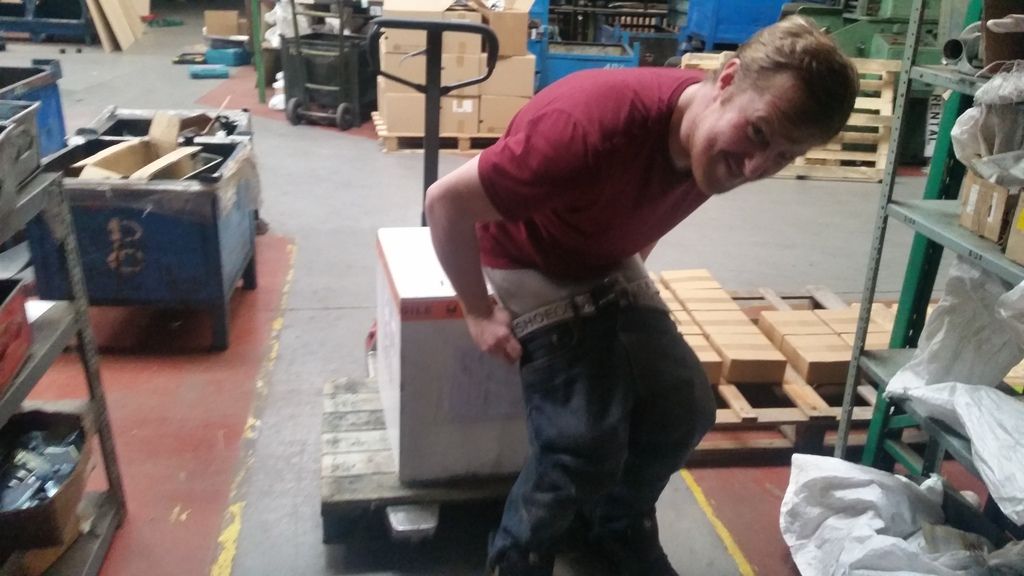I've had mixed success with cheap no-name bearings; sometimes they are just as good as an expensive one, occasionally they fail before the event.
Announcement
Collapse
No announcement yet.
RogueTwo Robots
Collapse
X
-
Needle rollers are pretty good as long as you run them on precision ground shaft.
The problem is the thrust needle bearings that tend to go with them are total ass, they break very easily. I replaced them with plastic washers called oilmids or some such and they were much more durable. Efficiency still goes out the window when turning with a setup like that however.. Not that big of a problem with a drum though me thinks!
That drum is looking proper nasty too
Comment
-
Though I have never had a drum spinner I can testify to the durability of taper roller bearings on fighting robots.
I calculate Saint has been in over 250 fights in it's life and in that time after all the flips and hits that robot has endured. The bearings on the big wheels are perfectly fine. the exact same system is now fitted to Gabriel.
But like anything they have to be fitted correctly. I'm sure Dave, myself or many others can advise.
Comment
-
Is it bad that I didn't even look at the tech specs? I just saw the dimensions and thought 'yeah they seem about right'Originally posted by overkill View PostThose bearings have excellent specs, with higher radial load capacity than a 20mm ID tapered roller bearing - you definitely exceeded Mouldy's design there

Just assumed they were decent since they were £20 a pop!
Comment
-
Update
Just back in from a 12-hour workshop session. I now have the back of a 70-year-old. Was back home yesterday but didn't manage to get a huge amount done, made up for it today though.
First up in Drumroll's ever continuing quest to become 720, front skids, needed to allow the drum teeth to clear the floor. Last year the bottom ones were ali and the top ones HDPE. This year I've just gone for Nylon for both, mostly as I had a block of spare material that was able to provide six skids (two spares) and it's pretty good for that sort of job. Last year's ones weren't hugely consistent - the bolt holes varied slightly in each - so I made a small drilling template this time and it was a huge improvement:

And the bottom ones fixed in place:

Still to mill a small chamfer into them but I'm hoping, time permitting, that I can incorporate the curvy front ends again this year so I'll wait until that's done (or not) before cutting the chamfer.
The drum teeth are pretty close to the ground but still a millimetre or two higher than I'd like, but I didn't want to skim them down any further as I'm expecting a bit of wear in them when I'm testing the robot's drive outside on the concrete and that may shave a little off slightly.
So that was Friday's endeavours. Today was an armour day. Knew it was going to take an absolute age but it needed done. Been deliberating between a couple of options for armour depending on weight, and since weight was looking good, I went for my first option, which is a 3mm steel angle frame with HDPE bolted on. Haven't cut the HDPE yet but here's where things stand with the frame. Cutting and shaping the first piece:

The sum of the angles involved comes to around 720°

The angle steel was welded to the steel plates that you can see fitted to the front and rear of the ali chassis. The welds were then cleaned up with a grinding/flap disc. The final shape is mostly there but I still need to hit them with the flap disc tomorrow just to clean them up fully. Would have done it today but time was getting on and the neighbours were probably sick of hearing the angle grinder all day:

Once complete, I weighed each section separately, and they were both around 620g each, much lighter than I was expecting. So with everything thrown on the scales again, here's where it's at:

There's still the HDPE to add to that, which is 8mm thick but I'll be layering it up to 16mm, as well as the usual collection of fixings. Should be comfortably underweight as I've still got the back-up of milling some weight out of the bulkheads, but may add a few supporting brackets etc to the innards where needed, mostly to stop any of the components from working their way into the belt transmission!
HDPE should be done tomorrow, post-chocolate. Had set a Sunday evening deadline for getting Drumroll done, allowing me to focus on Reaver and maybe Onyx, but it'll likely be Monday now before it's done, so that all but eliminates the possibility of cobbling Onyx back together for whiteboards (which is maybe a good thing if Shiny is going to be lurking in them!)
Comment
-
Oh, and forgot to mention that I popped the higher kv brushless motor into Drumroll yesterday and gave it a spin-up. 11,000rpm of fun
https://www.youtube.com/watch?v=MRrlMToNmEM
Comment
-
Copycat you say?

If it's any consolation, I'll be bending the HDPE with a heat gun which means it'll be more curvy than angular, so the final result will probably be closer to this, shape-wise:

(possible photo credit to Nick, can't remember if this was one of yours from RG08?)
Didn't do anything to bearings or drum setup when I swapped the motor over, but I didn't start the spin-up as slowly in that second video so that's perhaps why it sounds a little better.
Couple of reasons for going from all steel to steel/HDPE. Last year Drumroll took a hit from NST that buggered the bulkhead. Stupid design flaw aside, I couldn't hammer it back into shape at the event and had to get it flattened in a fly press. The hardox was also slightly bent out of shape but was able to just force it back into line using the bolts that held it on. However if that hadn't worked, I'd have been unable to reshape it at the event.
Contrarily, Carcinus took hits from a variety of spinners, including NST, and despite the claws suffering damage, the HDPE armour absorbed the brunt of the impacts and the chassis remained relatively unscathed. Additionally any damage on the HDPE could be sorted out with all manner of hand tools there and then.
So basically the steel frame is there to lend some strength but the HDPE should take the blows of spinner impacts without it having too detrimental an effect on the chassis, and as most of the damage should be on the HDPE, I can just clean it up, or unbolt that section and replace it with another piece, all at the event and without needing any special machinery.
You're right, Glen. It would have been more beneficial to bend the angle the other way, but I want as little steel exposed as possible, again for the reason that if a vertical catches it, it's more likely to gouge and toss the robot slightly if it gets the HDPE, whereas it would probably bend the steel as well as sending the robot flying.
Whether all that works in practice remains to be seen, but it works in my head. Although I have a substantial track record of engineering faux pas
Comment
-
Comment
-
The fact that Photobucket is trying to sell me a framed print of that is quite concerning...Originally posted by Mouldy View Post
Comment



Comment